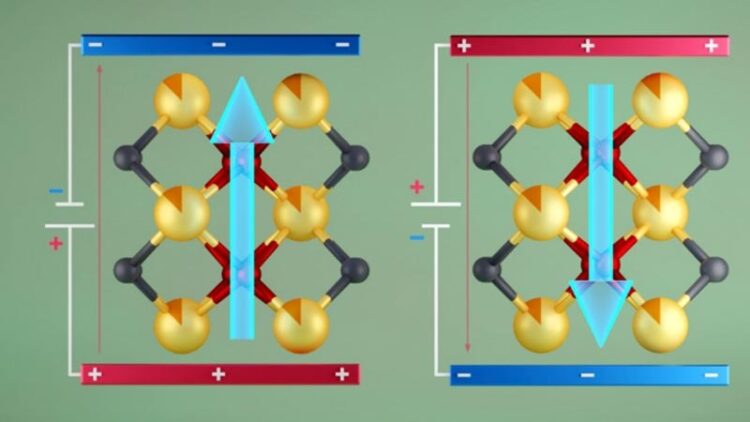Innovative ferroelectric material could enable next-generation memory devices

The structure of yttrium (partially shaded orange) doped hafnia dioxide crystals exhibits ferroelectric polarization (blue arrows) that changes direction as the external electric field is reversed.
Image courtesy of Oak Ridge National Laboratory
The first report of room temperature ferroelectricity in bulk hafnia could extend Moore’s Law for data storage.
The Science
Ferroelectric materials are substances with spontaneous electrical polarization. Polarization refers to the separation of the negative and positive charges within a material. For ferroelectric materials, this means the “memory” of the material’s prior state (referred to as hysteresis) can store information in a way similar to magnetic storage devices such as hard disks. Ferroelectric materials based on the element hafnium show promise because they are more compatible with today’s silicon computer circuits than other potential materials. In the past, researchers achieved ferroelectricity on ultrathin films. These films can be delicate and hard to use. Scientists have now reported the first experimental evidence of room-temperature ferroelectricity in crystals made of a hafnium-based compound, bulk yttrium doped hafnium dioxide.
The Impact
Hafnia-based ferroelectric materials have many benefits for computer memory. They offer high speed, durability, lower operating power, and the ability to retain data when power is turned off. However, researchers do not fully understand these materials. This research developed an innovative bulk hafnia-based ferroelectric material. The results provide insights into how these materials behave and how to control them. The results also remove the materials’ upper size limit, making such materials easier to use in real-world applications. The large sample size will aid further experiments to better understand the material’s ferroelectric properties. This in turn will help researchers create next-generation non-volatile memory devices.
Summary
Intel co-founder Gordon Moore postulated in 1965 that the number of transistors on a computer chip would double every two years, a prediction known as the Moore’s Law. Chip manufacturers since have been able to maintain this rate of miniaturization but face increasing challenges due to the laws of physics. Hafnia-based ferroelectric materials may help to further miniaturize non-volatile memory devices, but researchers have not developed a bulk form of the material. The new bulk ferroelectric yttrium doped hafnium dioxide developed in this research could enable such development, leading to more use of hafnia on computer chips and extending Moore’s Law.
A team of researchers led by Rutgers University performed neutron powder diffraction measurements on yttrium doped hafnium dioxide using the POWGEN, a general-purpose powder diffractometer instrument at the Spallation Neutron Source, a Department of Energy (DOE) user facility at Oak Ridge National Laboratory (ORNL). POWGEN is a high-resolution neutron powder diffractometer that enables characterizing the crystal, magnetic, and local structures of novel polycrystalline materials. The team synthesized single crystals of yttrium doped hafnium dioxide at various yttrium doping levels and ground them into powder for characterization. POWGEN data showed that at certain doping levels, the bulk phases were stable and the oxygen atoms shifted to enable reversible polarization, thus confirming the hafnia’s ferroelectricity at room temperatures. Other measurements, including polarization-electric field hysteresis loop and computational simulations, supported the structural analyses, representing an important step forward towards future hafnia-based technologies.
Funding
The research was supported by the Centre for Quantum Materials Synthesis funded by the Gordon and Betty Moore Foundation’s EPiQS initiative, Rutgers University, the Office of Naval Research, and the Department of Defense. The neutron characterization was performed with the Spallation Neutron Source, a DOE Office of Science user facility at ORNL.
Media Contact
Michael Church
DOE/US Department of Energy
michael.church@science.doe.gov
Office: 2028416299
All latest news from the category: Information Technology
Here you can find a summary of innovations in the fields of information and data processing and up-to-date developments on IT equipment and hardware.
This area covers topics such as IT services, IT architectures, IT management and telecommunications.
Newest articles

Universal and flexible use
A new type of wooden ceiling slab competes with traditional concrete slabs. As part of the EIC Pathfinder-funded research project “Universal Timber Slab”, scientists from the University of Stuttgart are…

World’s smallest molecular machine
… reversible sliding motion in ammonium-linked ferrocene. Researchers stabilized ferrocene molecules on a flat substrate for the first time, creating an electronically controllable sliding molecular machine. Artificial molecular machines, nanoscale…

Towards the control of chemical reactions
Overcoming one of the challenges of quantum mechanics: A major result in quantum mechanics has been achieved: for the first time, the temporal evolution of a quantum system has been…



